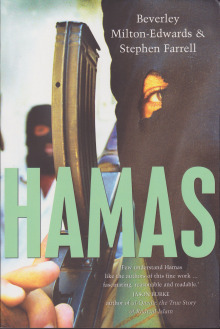Matt Rees's Blog - Posts Tagged "taliban"
An Islamic Romeo and Juliet
 Since 9/11, journalists and writers have tried to make sense of the extremists committed to the destruction of the West and, often, that of their own societies in the Middle East. Mostly this has meant “going inside” the world of those extremists, giving us the inner life of suicide bombers or of the “American Taliban.”
Since 9/11, journalists and writers have tried to make sense of the extremists committed to the destruction of the West and, often, that of their own societies in the Middle East. Mostly this has meant “going inside” the world of those extremists, giving us the inner life of suicide bombers or of the “American Taliban.”It’s a worthy premise, because it’s aimed at comprehending people who are frequently written off as bestial, bloodthirsty psychopaths, as though they’d been born that way. As a journalist with 14 years experience in the Middle East, I’ve written such stories often enough. But in my new novel I decided to highlight the desperate world of Arabs who struggle against the extremism that drags them toward their inevitable, tragic end. This is the most profound way of humanizing Arabs, because it shows them clinging to the very things that make them just like us, rather than succumbing to the ugliness of a politics that sets them against us.
That’s why I see my new crime novel, “The Fourth Assassin,” as an Islamic “Romeo and Juliet” set in the context of a political assassination plot in New York. I want to put a human face on Arabs, who’re so often seen as stereotypical terrorists. But I want to focus less on the pain and confusion that leads to hatred, and instead to reveal the love that can provide hope for Arab people in the face of so much destruction and division. To illustrate, for Western readers, what they’re up against, too.
“The Fourth Assassin” begins with Omar Yussef, the hero of my previous three Palestinian crime novels, arriving in New York for a UN conference. He uncovers an assassination conspiracy involving some of his former pupils from back home in Bethlehem. It unfolds in the neighborhood of Brooklyn called Bay Ridge. With its growing Palestinian community, Bay Ridge is in fact becoming known as “v”.
As he delves into the background of the plot, Omar looks for political explanations. That’s what journalists and writers typically do when they examine the Middle East. But gradually Omar sees that there’s a love story behind what’s happening. A love story between a young Sunni Muslim who has been sucked into the assassination plot and a Lebanese Shia girl who wants to enjoy the freedoms of American life.
The book’s a crime novel, so I’m not giving anything away when I say that Omar sees these lovers as tragic, somehow doomed by the politics around them. But he acknowledges – as the lovers do – that their human connection is so important that it’s worth any sacrifice. Just as Romeo does when he rails against the family politics that would deny him his Juliet and designate such divisions as fated. “Then I defy you, stars,” he calls out.
With Romeo and Juliet, the doom that surrounds them isn’t the point of the play. It’s their hope and defiance that draws them to us. If Shakespeare had written a three-hour examination of the political conflict between the Montagues and the Capulets, I don’t expect we’d pay it much attention these days. Neither would we be interested in the play had it focused on Tybalt, Juliet’s hot-headed, murderous cousin, or Mercutio, the pal of Romeo who shouts “a plague on both your houses” as he dies. Yet that’s exactly what journalists and writers give us in their attempts to “explain” the Arab world.
Love is what helps us to understand those who seem otherwise to be set against us. That’s what Omar Yussef learns in “The Fourth Assassin.” I hope the novel will help my readers see that love is as much a part of life for Arabs as the violence that dominates their portrayal in the news pages.
Published on April 02, 2010 02:05
•
Tags:
9-11, american-taliban, arabs, bay-ridge, bethlehem, brooklyn, crime-fiction, islam, lebanon, middle-east, montagues-and-capulet, new-york, omar-yussef, palestine, palestinians, romeo-and-juliet, shakespeare, taliban, the-fourth-assassin
Scribe and Scholar enter world of Hamas
 A New York Times correspondent teams up with a Belfast professor to write the story of Islamism among the Palestinians.
A New York Times correspondent teams up with a Belfast professor to write the story of Islamism among the Palestinians.JERUSALEM — Stephen Farrell was sipping coffee in the office of his money changer on Salah ud-Din Street, East Jerusalem’s main commercial strip, four years ago, when Beverley Milton-Edwards entered. From his rucksack, Farrell produced a copy of a book about Islamic militants written by the Queens University Belfast professor.
“Your book saved my life when I was kidnapped in Iraq,” he said, referring to a brief period of captivity by militants in Baghdad in 2004 when working for The Times of London. The dogeared volume had given London-born Farrell, now a New York Times foreign correspondent, the background he needed to convince his kidnappers that he had studied and understood their political and religious concerns. (Money may also have changed hands, of course...)
“That’s quite an endorsement,” Milton-Edwards responded. “Would you write that for the cover of my next book.”
Instead, he wrote an entire book with her. “Hamas: The Islamic Resistance Movement” (Polity Press) is the product of a decade in the Middle East for Farrell — who was kidnapped again, by the Taliban in Afghanistan, last September and freed by British commandos.
Surprisingly, given the amount of ink spilled over Hamas, it’s the first book broadly profiling the Islamic group that’s not written by an Arab or Israeli author. (GlobalPost correspondent Thanassis Cambanis may do the same for another militant group oddly neglected by Western book authors with his "A Privilege to Die: Inside Hezbollah's Legions and Their Endless War Against Israel," to be published September by Free Press.)
It’s certainly an opportune time for a history and analysis of Hamas. The group, which originated in Gaza during the first Palestinian intifada, transformed in recent years, initially killing more Israelis during the second intifada than previously would’ve been imaginable, then reversing its refusal to run in elections. Hamas won the parliamentary elections of 2006 and, in 2007, ran its rival Fatah out of the Gaza Strip, setting up the present quagmire of Palestinian politics.
I’ve known Farrell since he arrived in the Middle East for the London Times, having previously done a spell in Kosovo. He soon acquired a reputation for extreme thoroughness. On one visit to the southern Gaza Strip town of Rafah during the intifada, I ran into Farrell. He wasn’t there to cover a particular story. He said he hadn’t been busy, so he’d gone out to see what he might find. Given the volume of stories required of Jerusalem-based correspondents and the risks involved in getting to Rafah, extra-credit work such as this was rather unheard of.
“It’s very difficult to know something second-hand,” said Farrell, over coffee in a theater cafe in Jerusalem. “When you’re at the scene, things are so much more complex. That’s why you need to examine it in a book.”
Milton-Edwards provided much of the historical background that informs the book’s fascinating sections on the history of Islamism among the Palestinians before the foundation of Israel, and the activism in the 1970s of the men who would later form Hamas. But she, too, participated in much of the research on the ground, having a long-term knowledge of the place. She completed a Ph.D. on Hamas and Islamic Jihad after a media internship in Jerusalem during the first intifada.
That extensive research provides some of the most interesting snippets in the book. Hamas founder Ahmed Yassin was, in fact, an educator, not a religious leader, though he has been almost universally known as “Sheikh Yassin,” an honorific implying great Islamic learning.
The book’s historical perspective also provides surprising statistics. During the five years before the 2006 elections, Hamas had killed 400 Israelis. That’s an enormous toll, but amounts to just a couple of days work for Islamic radicals in Iraq about whom we know much less.
Written in a tone that tends closer to a plain academic style than the more trendy novelistic type of nonfiction book, “Hamas” doesn’t restrict itself to the politics and the violence. There’s a lengthy segment on the group’s approach to women — largely negative, particularly when seen through the eyes of the cosmopolitan leaders of the previous generation, like the chain-smoking Mariam Abu Dugga who wears no headscarf and used to be a member of the “Martyr Guevara” group.
Within Palestinian society, Farrell and Milton-Edwards examine Hamas’ treatment of those it considers collaborators with Israel or merely uncommitted to the Islamic lifestyle. Needless to say, it doesn’t look good.
“We don’t whitewash Hamas,” said Milton-Edwards. “We don’t ignore their cruelties.”
The more recent internal divisions within Hamas are laid out plainly and in a detail not found elsewhere. The book looks at the still burgeoning conflict between the group’s original leadership — no blushing softies, after all — and a new generation of military leaders in Gaza in particular which wants Hamas to adopt a “salafi” line akin to the even more uncompromising Islamists produced by the Gulf states. The less-than-encouraging news is that in the last year the “salafist” wing of Hamas has taken the upper hand over the relative moderates.
Behind all this Farrell and Milton-Edwards identify a failure of leadership on the part of Hamas and its Fatah rivals that’s summed up by Hanan Ashrawi, a former Palestinian peace negotiator quoted in the book: “Hamas had to learn very quickly how to be in power and Fatah has to learn how to be out of power. Both of them haven’t learned, really. Fatah is not used to being in opposition, it doesn’t know how to, and Hamas is not used to being in government, and it behaved like an opposition.”
(I posted this on Global Post. Read more of my dispatches.)
Published on April 25, 2010 02:00
•
Tags:
afghanistan, baghdad, belfast, beverley-milton-edwards, books, fatah, gaza, hamas, hanan-ashrawi, hezbollah, intifada, iraq, islam, jerusalem, middle-east, new-york-times, palestine, palestinians, polity-press, queens-university-belfast, reviews, sheikh-yassin, stephen-farrell, taliban, terrorism, thanassis-cambanis



